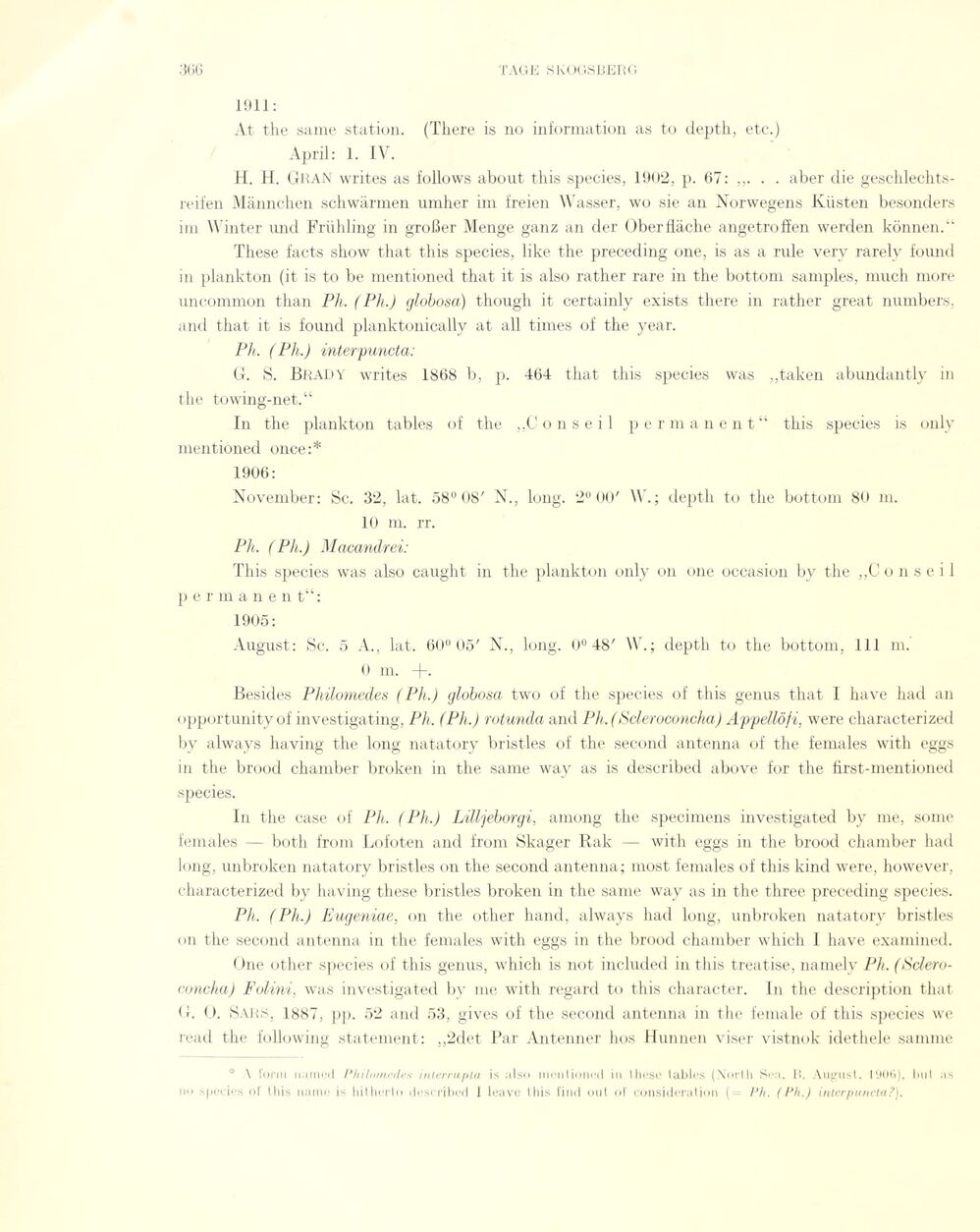
Full resolution (JPEG) - On this page / på denna sida - Sidor ...

<< prev. page << föreg. sida << >> nästa sida >> next page >>
Below is the raw OCR text
from the above scanned image.
Do you see an error? Proofread the page now!
Här nedan syns maskintolkade texten från faksimilbilden ovan.
Ser du något fel? Korrekturläs sidan nu!
This page has never been proofread. / Denna sida har aldrig korrekturlästs.
At the same station. (There is no information as to depth, etc.)
April: 1. IV.
H. H. Gran writes as follows about this species, 1902, p. 67: ,,. . . aber die
geschlechts-reifen Männchen schwärmen umher im freien Wasser, wo sie an Norwegens Küsten besonders
im Winter und Frühling in großer Menge ganz an der Oberfläche angetroffen werden können.“
These facts show that this species, like the preceding one, is as a rule very rarely found
in plankton (it is to be mentioned that it is also rather rare in the bottom samples, much more
uncommon than Ph. (Ph.) globosa) though it certainly exists there in rather great numbers,
and that it is found planktonically at all times of the year.
Ph. (Ph.) interpuncta:
G. S. Brady writes 1868 b, p. 464 that this species was ,,taken abundantly in
the to wing-net.“
In the plankton tables of the „Conseil permanent“ this species is only
mentioned once:*
1906:
November: Sc. 32, lat. 58° 08’ N., long. 2° 00’ W. ; depth to the bottom 80 m.
10 m. rr.
Ph. ( Ph.) Macandrei:
This species was also caught in the plankton only on one occasion by the „Conseil
permanent“:
1905:
August: Sc. 5 A., lat. 60° 05’ N., long. 0° 48’ W.; depth to the bottom, 111 m.
0 m. +.
Besides Philomedes (Ph.) globosa two of the species of this genus that I have had an
opportunityof investigating, Ph. (Ph.) rotunda and Ph.(Seleroconcha) Appellöfi, were characterized
by always having the long natatory bristles of the second antenna of the females with eggs
in the brood chamber broken in the same way as is described above for the first-mentioned
species.
In the case of Ph. ( Ph.) Lilljeborgi, among the specimens investigated by me, some
females — both from Lofoten and from Skager Rak — with eggs in the brood chamber had
long, unbroken natatory bristles on the second antenna ; most females of this kind were, however,
characterized by having these bristles broken in the same way as in the three preceding species.
Ph. (Ph.) Eugeniae, on the other hånd, always had long, unbroken natatory bristles
on the second antenna in the females with eggs in the brood chamber which I have examined.
One other species of this genus, which is not included in this treatise, namely Ph.
(iSclero-concha) Folini, was investigated by me with regard to this character. In the description that
G. 0. Sars, 1887, pp. 52 and 53, gives of the second antenna in the female of this species we
read the following statement: „2det Par Antenner hos Hunnen viser vistnok idethele samme
V lorm named Philomedes interrupta is also mentioned in these tables (North Sea. 1». August. 1906), hul as
iio species of this uame hitherlo described I leave this find out of considération (= Ph. ( Ph.) interpuncta?).
<< prev. page << föreg. sida << >> nästa sida >> next page >>